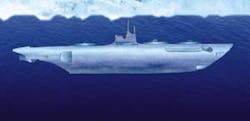Submarine LNG tankers to carry Russia's ice-bound Kara Sea gas to Asia
Dev George
Managing Editor
Map of Kara Sea and transport route to Japan and China. Proposed route of Werner's submarine fleet.Russia's Kara Sea may very well replace both the Gulf of Mexico and the North Sea as the world's primary source of gas reserves for the first half of the 21st century. Its giant gasfield Rusanovskaya is believed to hold gas reserves of 282 tcf and up to 4 billion bbl oil, and the Leningradskaya and Zapadno-Sharapovskaya Fields, just 30 and 80 miles south of Rusanovskaya, respectively, could both prove to be supergiants near or greater than Rusanovskaya, if current studies prove correct - certainly enough to supply Japan and China for the next 250 years.
Rusanovskaya, with a water depth of only 50 meters, and the related structures of the Kara Sea shelf are, however, icebound approximately ten months of the year and are only accessible with icebreakers. Several proposals have been made for exploiting these enormous reserves, but the usual configuration of arctic rigs and concrete platforms put forth by the Russians and occasional Western oil companies simply can't handle the Kara Sea ice. Furthermore, although Europe may be a market for the huge gas reserves of the Barents Sea to the west, Asia is a more likely market for those of the Kara Sea.
Faced with these daunting conditions, few operators have made overtures to the Russians for tapping the Kara Sea's resources until now. Recently, the American company Werner Offshore proposed a unique solution to the quandary - submarine production and a fleet of submarine LNG tankers.
Submarine Solution
Jules Verne foresaw the conduct of commerce beneath arctic ice back in 1870, with the publication of his remarkable adventure tale, Twenty-Thousand Leagues Under the Sea. In that classic science fiction novel, he told how the mighty Nautilus submarine commanded by the indomitable Captain Nemo, mined the ocean floor and plied the frigid polar waters at a depth of 3,000 ft beneath more than 4,000 ft of ice.Only the US nuclear submarines Nautilus and Skate have since traversed the polar ice cap, in 1958, via the Northwest Passage from the Atlantic to the Pacific. During World War II, however, in the Battle of the Atlantic, German U-boats constantly patrolled the Atlantic to sink Allied ships, and to keep them constantly on duty, a fleet of submarine tankers carrying diesel fuel hid beneath the polar ice until needed, then sailed out to refuel the U-boats.
Dubbed "Milch Kuhs", or "Milk Cows", the U-boat tenders were actually modified U-boats themselves. They were built at the Deutsche Werke and Germaniawerft in Kiel, Germany, with a length of 67 meters and width of 9.35 meters. They each carried just over 200 tons of diesel fuel and a crew of about 60 men.
Herbert Werner, head of Werner Offshore, was a U-boat commander during World War II. To approach the problem of tapping the Kara Sea's gas resources and transporting them to market, he remembered the near-forgotten Milk Cows of the German Navy and adapted the idea of submarine tankers to meet the difficult conditions to be encountered. Once conceived, Werner took his ideas to the Russians and consequently signed a joint venture agreement to exploit the Rusanovskaya and Leningradskaya Fields.
Werner plans to build a fleet of 22 submarine tankers by the year 2013 at a new shipyard set to begin construction in Vladivostok in 1997, which will be jointly operated by Werner Offshore and its Russian partners. The tankers will be 1,300 ft long with a capacity of 170,000 cubic meters of LNG. They will be manned by a crew of 14 and powered with an air-independent, closed-cycle diesel system from CDSS of the UK.
Werner's production scheme consists of a fully automated, subsea production system - designed by Werner Offshore - which will produce the oil and gas, with the oil piped to conventional surface tankers for transport to Europe. The gas, however, will be piped to a gas liquefaction plant on the coast of Novaya Zemlya Island, where it is to be processed into LNG, then transferred to submerged submarine LNG tankers.
The plan is for Werner's submarine LNG tankers to carry the gas in an 11-day voyage under the polar ice across the Kara, Laptev, and East Siberian Seas of the frozen Arctic Ocean north of Russia to Alaska's St. Matthew Island, in the Pacific Ocean's Bering Sea. Once at St. Matthew, the LNG is to be transferred to conventional surface LNG tankers for further transport to Japan or China.
The first voyage of LNG under the arctic ice is expected to occur in May 2004. Werner Offshore predicts peak production will find the submarine fleet carrying more than 21 million tons of LNG a year.
An artist's conception of the Werner LNG submarine tanker.
Copyright 1997 Oil & Gas Journal. All Rights Reserved.
